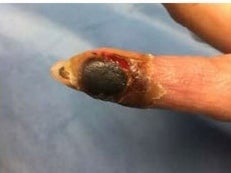Lab worker accidentally injects herself with genetically modified strain of smallpox-related virus
Warning: This article contains images some readers may find distressing
Your support helps us to tell the story
From reproductive rights to climate change to Big Tech, The Independent is on the ground when the story is developing. Whether it's investigating the financials of Elon Musk's pro-Trump PAC or producing our latest documentary, 'The A Word', which shines a light on the American women fighting for reproductive rights, we know how important it is to parse out the facts from the messaging.
At such a critical moment in US history, we need reporters on the ground. Your donation allows us to keep sending journalists to speak to both sides of the story.
The Independent is trusted by Americans across the entire political spectrum. And unlike many other quality news outlets, we choose not to lock Americans out of our reporting and analysis with paywalls. We believe quality journalism should be available to everyone, paid for by those who can afford it.
Your support makes all the difference.A 26-year-old lab employee accidentally injected herself with a smallpox-related virus during an experiment, US health experts have said.
The woman’s finger swelled up and turned black, before she recovered, according to the Centre for Disease Control and Prevention.
The San Diego resident began working with the vaccinia virus, which is related to smallpox, at a laboratory in September 2018.
The vaccinia virus is used to make smallpox vaccines.
The lab employee, who has not been named, was offered an inoculation against the virus before starting her new job but refused it.
Smallpox vaccines contain a live virus and can often lead to a lesion at the vaccination site, which usually heals.
The woman was worried about the side effect and opted not to be inoculated.
“Although the patient had declined vaccination when it was initially offered, during this investigation she reported that she did not appreciate the extent of infection that could occur,” the CDC said.
In December 2018, the lab worker accidentally pricked her index finger with a needle.

She was trying to inject the virus into a mouse’s tail for an experiment, the CDC report said.
“The worker immediately rinsed her finger with water for 15 minutes [and] notified her supervisor,” the CDC said.
She also went to hospital but was unable to remember which strain of the virus she had used.
“The patient was injecting multiple groups of mice with different strains and did not recall which strain she used when the needlestick injury occurred,” the CDC said.
Investigators examining the case eventually discovered that one of two genetically altered vaccinia strains was likely to have been used.
Ten days after the accident the woman’s finger swelled up and a black lesion developed on her finger.
By day 12, she had developed a fever with a 38C temperature.
Doctors became concerned about her condition and began treating her with tecovirimat, a newly-approved drug for smallpox.
She began to recover within 48 hours of being given the medicine.
The woman is the first person to be treated with tecovirimat for a lab-acquired infection from vaccinia virus.
She was banned from lab work for around four months because of the risk of infection to others. The areas of dead tissue on her fingers did not heal for around three months.
The CDC recommends that people working with such viruses are given the smallpox vaccine.

Join our commenting forum
Join thought-provoking conversations, follow other Independent readers and see their replies
Comments